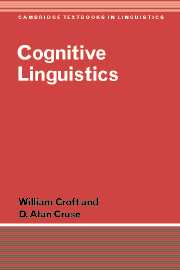Book contents
- Frontmatter
- Contents
- Figures
- Tables
- Preface
- 1 Introduction: what is cognitive linguistics?
- A conceptual approach to linguistic analysis
- 2 Frames, domains, spaces : the organization of conceptual structure
- 3 Conceptualization and construal operations
- 4 Categories, concepts and meanings
- Cognitive approaches to lexical semantics
- Cognitive approaches to grammatical form
- References
- Index
- Index
2 - Frames, domains, spaces : the organization of conceptual structure
Published online by Cambridge University Press: 05 June 2012
- Frontmatter
- Contents
- Figures
- Tables
- Preface
- 1 Introduction: what is cognitive linguistics?
- A conceptual approach to linguistic analysis
- 2 Frames, domains, spaces : the organization of conceptual structure
- 3 Conceptualization and construal operations
- 4 Categories, concepts and meanings
- Cognitive approaches to lexical semantics
- Cognitive approaches to grammatical form
- References
- Index
- Index
Summary
Arguments for frame semantics
What is it that words denote, or symbolize as cognitive linguists usually put it? A simple assumption that has guided much research in semantics is that words denote concepts, units of meaning. Concepts symbolized by words such as stallion and mare can be compared and contrasted with one another. Comparisons of words is the approach taken by structural semantics, which analyzes types of semantic relations among words, including hyponymy and antonymy. Some approaches to (lexical) semantics have proposed that word concepts such as STALLION and MARE are not atomic. Many concepts can be broken down into semantic features, so that STALLION is [EQUINE, MALE], and MARE is [EQUINE, FEMALE]. Finally, in the logical tradition that underlies much work in semantics, concepts are ultimately defined by their truth conditions: the conditions under which one can say that a concept does, or does not, appropriately apply to a situation in the world.
In this widespread approach to semantics, it is recognized that concepts do not simply float around randomly in the mind. First, there are the relations between words and their corresponding concepts described by structural semantics. But there has been a strong feeling that concepts are organized in another way as well. Certain concepts ‘belong together’ because they are associated in experience. To use a classic example (Schank and Abelson 1977), a RESTAURANT is not merely a service institution; it has associated with it a number of concepts such as CUSTOMER, WAITER, ORDERING, EATING, BILL. These concepts are not related to RESTAURANT by hyponymy, meronymy, antonymy or other structural semantic relations; they are related to RESTAURANT by ordinary human experience.
- Type
- Chapter
- Information
- Cognitive Linguistics , pp. 7 - 39Publisher: Cambridge University PressPrint publication year: 2004
- 1
- Cited by

